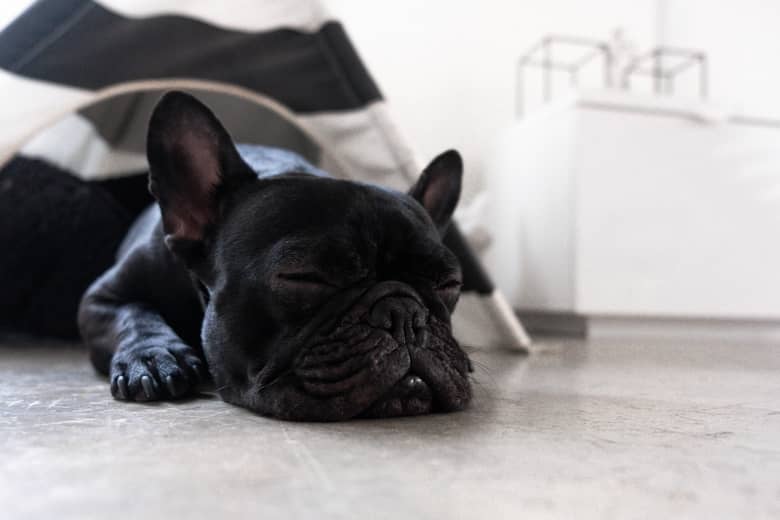While you may enjoy a trip to a salon for a bit of pampering in order to get your nails done, this is not always true of your pet. Your pup may be nervous or frightened at the prospect.
This situation may require a little more than a pat on the back and some encouraging words. So, you may be wondering, just how do I sedate my dog to cut his nails?
What can I give my dog to calm him down to cut his nails?
When choosing a sedative for your dog, there are a number of options available. Some products like Benadryl or Melatonin, are available over the counter, but others, like Acepromazine, will require a prescription. Be aware that anytime you sedate a dog, you must seek advice from a professional to avoid dangerous consequences.
As you’ll see below, sedating your dog is not so easy and can be quite dangerous. If you prefer a more risk free alternative, please check this guide.
Be Aware!
Sedation is a complicated procedure, and should be undertaken only by a professional. You certainly wouldn’t attempt to medicate yourself at home prior to a complicated medical or dental procedure, so you should treat your pet with the same consideration.
Any substance used in this process should be considered a medication, whether purchased over the counter or by prescription, and must be treated as such.
Only a qualified professional will know how to safely sedate a dog. He can decide on the proper dosage of a drug, and advise you on how to administer it.
Moreover, your canine should be examined by a vet before you even consider any type of sedation to determine what substance will work most advantageously with the least side effects.
This is especially true if the animal is already on other medications, as some sedatives may interact adversely with other medications.
Certainly, your canine companion will need his long nails trimmed from time to time, but there is no reason to make this any riskier than it should be. So, seek veterinary assistance before you try to do anything.

Substances that can be used
Benadryl
This is a common medication used to sedate a dog for nail clipping . You may be familiar with the name, as it is commonly used in humans as well.
This is an antihistamine used to treat allergies, both environmental and circumstantial.
Your vet may advise you to use this substance if your four-legged buddy has been stung, or has a reaction to pollen in the spring. But it also has a mild sedative effect, and can be used to calm nervous dogs .
Most tablets are available in 25mg sizes.
But remember to seek veterinary assistance before you give your dog any medicine, as there are certain conditions which could make such use dangerous, such as glaucoma, high blood pressure, or cardiovascular disease.
Melatonin
Melatonin is yet another commonly used human substance, available over the counter, you can use it to sedate a pup who is anxious.
Although Melatonin has not been approved by the Federal Drug Administration for use in animals, it has been used for years under veterinary supervision, with much success and very few, and usually minor side effects.
This substance is commonly used on a continual basis to treat overactivity in companion animals, epilepsy, and even hair loss. It can also be sued as needed to ease nervousness during thunderstorms or fireworks, or simply to allow for a good night’s sleep.
As with any medicine, seeking advice will be necessary before you consider dosing up your best friend, as there are a number of things to consider.
A professional will be able to determine the safe dosage, and even if your four-legged buddy would benefit from the medication.
Melatonin has been known to work poorly with some other medications your canine buddy may be taking, and should not be used at all by pregnant dogs or puppies.
There have been some side effects reported, although rarely. These can include stomach upset and/or cramping, itching, confusion, and tachycardia. Your veterinarian will advise you how to handle these.
While the two drugs mentioned above are available over the counter, other appropriate medications will require a prescription.

Diazepam
Have you ever thought of giving your furry companion a dose of Valium ? Well, this commonly used human drug, with the generic name Diazepam, has also been used on pets who are prone to convulsions, over excitement, or who are in need of a muscle relaxant.
Just as in human usage, Diazepam comes with a plethora of warnings. It may interact adversely with a variety of other medications your animal may be on, it can leave your friend weak and uncoordinated, and, if used on a continual basis, you may find yourself dealing with an addiction. That’s right, your pup may turn into a junkie.
Despite the fact that the FDA has not approved diazepam for use on animals, your veterinarians is fully qualified to prescribe its use.
However, you can only obtain it from a licensed vet ’s office.
Diazepam is a controlled substance, and, as such, should be administered and stored with care.
Acepromazine
Another prescription medication available is Acepromazine. This drug has been approved for administration to your canine companion before and after surgical procedures, as well as to control overly excited pups in stressful situations.
If you are considering using this to ease the situation before attempting to clip the dog’s nails, seeking veterinary assistance will be necessary, as only a professional is qualified to prescribe the drug, advise you on its efficacy and appropriateness, and warn of any side effect which may arise.
This drug may be contraindicated if there is a history of liver disease, heart disease, seizure disorders, or if the animal in question is pregnant or lactating.
Side effects are rare, but there could be an allergic reaction. Other signs may include difficulty in breathing, swelling in the face, lips, or tongue, and hives.
This drug can be very effective, as well as affordable, since it is sold as an individual tablet to be used as needed.
Keep in mind!
Sedation is complicated, and the used medications, whether available over the counter or by prescription, should only be used under the direction and guidance of a qualified veterinarian .
Calming Your Dog with natural solutions
Perhaps you’d feel comfortable dealing with the situation in a more homeopathic manner rather than using some doggy Valium.

Aromatherapy
Aromatherapy is one way to go. Try massaging a small amount of lavender oil onto the back of your pooch’s neck, or at the base of his spine. Lavender has been known to have a calming effect.
Pheromones
Pheromones may also be the answer to your excitable companion’s phobia of nail clippers .
Try a sentry calming collar, or a comfort zone diffuser with appeasing pheromones.
These products contain the same pheromones produced by mamas to comfort their puppies, and have a calming effect on adult dogs as well.
herbs
Herbal alternatives are also on the market. You could try Dorwest Herbs Scullcap and Valerian Tablets, as the herbs they contain have been proven to be effective against nervousness, excitability, restlessness, and anxiety. But don’t use this on lactating mothers or puppies under two months old.
Another herbal choice is Vetzyme Stay Calm liquid, which contains a combination of chamomile and ginger. Simply follow the dosing recommendations and mix in with your fido’s daily meals.

Dealing with An Animal’s fear Of getting The Toenails Clipped
While some people choose to do this at the vet or with the help of groomers, there are certainly other ways of easing your pup’s fear of the clippers , or eliminating, the anxiety and the freaking out involved in this terrifying experience, at the comfort of your home.
The most obvious way is to eliminate the need for trimming at all by using other methods to clip the toenails.
Enough exercise may lead to the wear and have the same result as if you were to clip the nails, so they will require no trimming. Running on asphalt is a good example of a workout routine.
Some folks use motion sickness pills, but remember to consult someone before drugging your dog. Even an innocent pill could be dangerous.
You can even try the nail trimming process while your dog is sleeping. Try to approach your sleepy pup with the toenail clippers. Grab the toenail and do one nail at a time. Remember to keep these clipping sessions short.
You could also try using rough floor mats specially designed to wear down long dogs nails . Or teach a behavior such as scratching or running the paw over a sandpaper covered board.
The latter will involve multiple training sessions, but will allow you to escape the trauma when you start to trim the nail .
Another stress free alternative is to use a special harness to restrain your pooch.
Others even use tools like a dremel sanding drum !
Finally, you could embark on a daily training program. If you’re willing to invest the time needed to train your dog, the results will amaze you!
Start with a new nail grinder, as the old one may evoke bad memories. And make sure it is sharp, and continues to be sharpened regularly. A dull tool can make for a painful experience.
You may want to get a styptic powder or quick stop in case a bleeding happens during the trimming.
Start with getting your pooch accustomed to having his paw handled before you try to trim it. Then introduce him to the tool itself, but with no sound.
Gradually, while holding the operating device in your hand, put it near his legs for few minutes until he is accustomed to seeing and hearing it, and having his feet and paws handled, without concern.
Do Not try to restrain him by force. Restraining could do more harm than good.
When you feel he is ready, try to complete the process and avoid cutting the quick .
Once you clipped the nails, reward your dog with treats. The next time, he will let you hold his paw with joy.
Remember, this is not a quick surgery. This whole routine will require more than a bit of time and patience, but the reward will be great for you both when this trick works.
Related Questions
How to cut a Dog’s Nails Without Clippers?
If your dog is sensitive to clippers or doesn’t like them at all, you should get a Dremel tool made for trimming their nails. These specialized tools wear down the nail and are sold at most pet supply shops or online retailers.
Dremel tools can make a lot of noise so you should start it early to get your pet used to the noise. You also want to acclimate them to the vibration of the tool by pressing the non-cutting end of the tool into their fur until they are used to it.
Hold their paw with one hand and the tool with the other. Apply it in short sessions at first. Focus on one or two nails at a time.
Avoid grinding too quickly as there is a living area in the middle of their claws. It can bleed out and hurt your canine buddy if you cut into it.
The more you use the tool the more a pup gets used to it, and the more you can cut with each session.
How to Cut an Uncooperative Dogs Nails?
Try to see things from your pup’s point of view. Most pups don’t like being restrained and they don’t like the feeling of being restrained either.
Your pooch might just be afraid of nail clipping, and it’s up to you to calm them down.
This is especially true if you have an aggressive dog, or if your dog bites when you attempt cutting the nails.
However, this doesn’t mean that you should let them run riot with untrimmed nails.
What you need is the right tools for the job.
You’ll need;
- Nail clippers
- A Dremel tool
- Nail file
Here’s what to do;
Use Sharp Tools! Make sure you have good quality sharp clippers. Dull blades can pinch and/or crush the nail and cause it to split. Having sharp clippers offers a quicker, cleaner, and better cut. This makes things less stressful for all involved.
Try Filing! Try manually filing the nails down instead of using a clipper. Filing is more time-consuming than clipping, but it puts less pressure on your canine. Just keep in mind that dogs will, in general, prefer a fast option to get everything over and done with.
Try Using a Dremel! Dremel tools work without having to pinch or hold the nail by grinding away at it instead. Just make sure your pup is used to the sound and feel of the tool before using it.
Create Positive Associations! No matter what tool you use, you want to create positive associations with it. Try keeping the tool near their dinner during meal time or having it around when offering treats and when not using it.
Do Long Nails Hurt Dogs?
Leaving your dog’s nails untrimmed can do a lot of damage, some of which can be irreversible.
When pups put their feet on the ground and hit it with their nails, it puts force on their feet and legs.
Long nails can take a healthy paw and make it into a splayed foot that has less traction. It can also injure tendons and deform their feet.
How Much Does it Cost to Sedate a Dog for Nail Trimming?
Sedating a pooch is one option if they are particularly bad with nail trimming. Some professional dog groomers offer sedation as an extra service and there are several over the counter options available.
The cost of sedating a dog can depend on the sedative used on them. Different products can also serve different purposes.
It’s hard to put an exact price on the cost of sedation for trimming, but sedation itself can cost anywhere between $10 and $350. Just be careful to choose the best sedative and the right dose for the job.
How Often Should Dog’s Nails be Clipped?
While there are a few factors involved – such as age, breed, and activity level – on average you should trim your dog’s nails every 1 to 2 months. An obvious sign that they need to be trimmed is if they start clicking on the floor as your furry friend walks around.
How Much do Vets Charge to Trim Nails?
You could have your vet take care of this. The exact cost will depend on your vet so be sure to ask their costs. In general though, you can expect the service to cost between $7 and $20. It may be possible to have their nails ground down rather than clipped, which can be more expensive. Once again, ask your vet what services they offer and how much they charge for them.
Does Cutting a Dog’s Quick Hurt?
The “Quick” is the soft inner part of the nail which is innervated and vascularized.
It presents a risk when clipping, but it should be fine as long as you are careful and don’t cut too close. However, it’s going to hurt if you cut it.
That’s why choosing the correct angle to cut a dog’s nails is very important.
Don’t panic if it gets cut though. Just apply pressure, a cold compress/ice, stypic powder, and a bandage. Treat it like you would treat a human wound and things should be fine. If you are worried at all just give your vet a call.
Conclusion
Just like grooming, your pooch surely will need his nails clipped from time to time.
Whatever way you choose to alleviate your furry friend’s anxiety, be it medications, homeopathic remedies, or conditioning and behavior training , it is worth the effort.
Your companion animal will be spared the discomfort of walking around the house on painfully uncomfortable nails, and your floors and furniture will be spared from the wear and tears such paws can inflict. Not to mention your own delicate skin.
